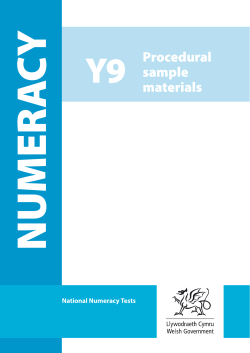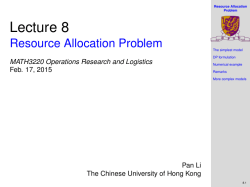
2140606 - Gujarat Technological University
GUJARAT TECHNOLOGICAL UNIVERSITY CIVIL ENGINEERING (06) NUMERICAL AND STATISTICAL METHODS FOR CIVIL ENGINEERING SUBJECT CODE: 2140606 B.E. 4th Semester Type of course: Engineering Mathematics Prerequisites: The students are required to have a reasonable mastery over calculus, Differential equations and Linear algebra and introductory knowledge of probability and statistics. Rationale: Mathematics is a language of Science and Engineering. Teaching and Examination Scheme: Examination Marks Total Marks Theory Marks Practical Marks ESE PA (M) PA (V) PA (E) (I) PA ALA ESE OEP 3 2 0 5 70 20 10 30 0 20 150 L- Lectures; T- Tutorial/Teacher Guided Student Activity; P- Practical; C- Credit; ESE- End Semester Examination; PA- Progressive Assessment L Teaching Scheme T P Credits C Content: Sr. No. 1 2 3 4 5 6 Topics Probability Reorientation: Definition of probability, Exhaustive events, Pair wise independent events, Multiplicative law of probability, Conditional probability, Baye’s theorem Probability Distributions: Random variable, Mathematical Expectation, Standard Deviation, Binomial, Poisson and Normal distributions, Mean, Median, Mode Statistics Descriptive Statistics: Mean, Median, Mode, Standard deviation, Skewness Correlation and Regression: Bivariate distribution, Correlation coefficients, Regression lines, Formulas for Regression coefficients, Rank correlation Curve Fitting: Fitting of Linear, Quadratic, Exponential and Logarithmic curves, Least squares method Numerical Methods Finite Differences and Interpolation: Finite Differences, Forward, Backward and Central operators, Interpolation by polynomials: Newton’s forward ,Backward interpolation formulae, Gauss & Stirling’s central difference formulae , Newton’s divided and Lagrange’s formulae for unequal intervals Teaching Hrs. Module Weightage 03 07 05 12 03 08 04 10 03 08 08 15 7 Numerical Integration: Newton-Cotes formula, Trapezoidal and Simpson’s formulae, error formulae, Gaussian quadrature formulae 03 08 8 Solution of a System of Linear Equations: Gauss elimination, partial pivoting , Gauss-Jacobi and GaussSeidel methods 03 07 9 Roots of Algebraic and Transcendental Equations: Bisection, false position, Secant and Newton-Raphson methods, Rate of convergence Numerical solution of Ordinary Differential Equations: Taylor series method, Euler method, Runge-Kutta method of order four, Milne’s Predictor-Corrector method 04 10 06 15 10 Suggested Specification table with Marks (Theory): R Level 10 Distribution of Theory Marks U Level A Level 15 20 N Level 20 E Level 35 Legends: R: Remembrance; U: Understanding; A: Application, N: Analyze and E: Evaluate and above Levels (Revised Bloom’s Taxonomy) Note: This specification table shall be treated as a general guideline for students and teachers. The actual distribution of marks in the question paper may vary slightly from above table Reference Books: Reference Books: 1. E. Kreyszig, Advanced Engineering Mathematics(8th Edition), John Wiley (1999) 2. S. D. Conte and Carl de Boor, Elementary Numerical Analysis-An Algorithmic Approach (3rd Edition), McGraw-Hill, 1980 3. C.E. Froberg, Introduction to Numerical Analysis (2nd Edition), AddisonWesley,1981 4. Gerald C. F. and Wheatley P.O. , Applied Numerical Analysis (5th Edition), Addison-Wesley, Singapore, 1998 5. Johnson Richard A., Miller and Freund's - Probability and Statistics (8th Edition) , PHI. 6. S.C. Gupta and V. K. Kapoor, Fundamentals of Mathematical Statistics (11th Edition), Sultan Chand & Sons. Course Outcomes: After learning the course the students should be able to : o o Understand and apply the basic concepts of probability, random variables, probability distribution. Use statistical methodology and tools in the engineering problem solving process. o o o o o Compute and interpret descriptive statistics using numerical and graphical techniques Understand the basic concepts of regression and curve fitting Calculate finite differences of tabulated data. use numerical methods to find integration and differentiation find an approximate solution of algebraic equations using appropriate method. o find an approximate solution of ordinary differential equations using appropriate iterative method. List of Open Source Software/learning website: http://nptel.ac.in/courses/111101003/ http://nptel.ac.in/syllabus/syllabus.php?subjectId=111101004 http://nptel.ac.in/courses/111105038/ http://nptel.ac.in/courses/111107063/ http://nptel.ac.in/courses/111105041/ http://nptel.ac.in/courses/111104079/ ACTIVE LEARNING ASSIGNMENTS: Preparation of power-point slides, which include videos, animations, pictures, graphics for better understanding theory and practical work – The faculty will allocate chapters/ parts of chapters to groups of students so that the entire syllabus to be covered. The power-point slides should be put up on the web-site of the College/ Institute, along with the names of the students of the group, the name of the faculty, Department and College on the first slide. The best three works should submit to GTU.
© Copyright 2025





















